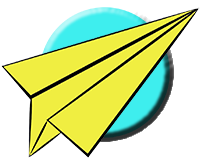Kookaburra Paper Airplane Step-by-step
Kookaburra Paper Airplane Step-by-step
Instructions
1. Fold the upper left corner down so the upper left point hits the right edge of the paper. When folded correctly, the top edge should line up with the right edge of the paper. Unfold after the crease has been made.
2. Fold the upper right corner down so the upper right point hits the left edge of the paper. When folded correctly, the top edge should line up with the left edge of the paper. Unfold after the crease has been made.
3. Flip the paper over keeping the creases towards the top.
4. Fold the upper edge of the paper down making a crease which goes through the point in the center formed by the existing diagonal creases.
5. Unfold the paper and lay it flat on the working surface.
6. Flip the paper over, keeping the creases just made towards the top.
7. Pop the left and right horizontal creases up, bringing the points at the ends of the creases in and down towards the center of the paper. When folded correctly, a new flap is formed sticking straight up from the paper's base.
8. Split the layers of the flaps apart bringing the points at the flap tips down towards the point at the edges of the paper. Bring the top point, where the flap meet, straight down and press the whole fold flat.
9. Using the first two layers of the triangular topmost flaps, make a crease about two finger widths from the bottom edge. The bottom layer must stay in place so two hinges must be created between the 2nd and third layers. This is a tough fold, so take some time to get it right!
10. Flip the paper over keeping the nose at the top.
11. Make a crease to fold the nose tip down. The new crease should be about three finger widths down from the point at the tip of the nose. When folded correctly, the center line creases should line up.
12. Rotate the plane around so the nose points to the left. Fold the plane exactly in half. Be sure the wing flaps line up for good balance.
13. Rotate the plane around so the nose points to the right and the wing flaps point up.
14. Make a crease to fold down the landing skid. The right point of the crease should be where the diagonal edge hits the front of the nose. The crease should be slightly angled going up from right to left.
15. Fold the bottom tip of the landing skid back on top of itself. Make the crease so the newly created triangular flap fits exactly on top of the small triangle underneath. The left edge of the new flap should line up with the right edge of the larger triangle above.
16. Unfold the landing skid but not the small triangular flap which was just created.
17. Flip the plane over so the nose is pointing to the left and the wing flaps are pointing up.
18. Make a crease to fold down the landing skid. The left point of the crease should be where the diagonal edge hits the front of the nose. The crease should be slightly angled going up from left to right.
19. Fold the bottom tip for the landing skid back on top of itself. Make the crease so the newly created triangular flap fits exactly on top of the small triangle underneath. The right edge of the new flap should line up with the left edge of the larger triangle above.
20. Unfold the landing skid but not the small triangular flap which was just created.
21. Flip the plane over so the nose points to the right and the wing flaps point up.
22. Make a crease to create the first wing flap. The right point of the crease should be about one finger width up on the bottom edge of the fuselage and the left point should be about two finger widths up on the tail.
23. Make a crease to create the first wing flap. The right point of the crease should be about one finger width up on the bottom edge of the fuselage and the left point should be about two finger widths up on the tail.
24. Make a crease to create the second wing flap. Be sure the wing flaps are line up for good balance.
25. Open up the wing flaps and adjust the wing angles. Bring the landing skids up with the wing flaps. Set the dihedral angle flat or slightly up.
26. Drop the landing skids down from the wing flaps. This fold also shows the plane separating at the fuselage to better illustrate the dimensions of the plane.
27. Unfold the landing skid tips. The landing skids and tips may be adjusted to many angles; the angles are not too important, just be sure there are balanced from left to right.
THE THROW This craft can be tricky to trim and fly. A piece of tape across the midsection will help to stabilize the flight. Add slight up elevator and make sure the landing flaps are even. Launch with a soft to medium level throw.
